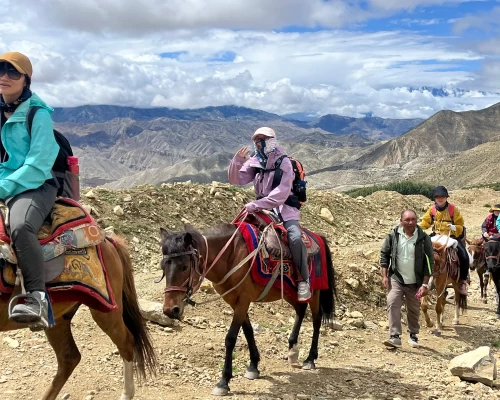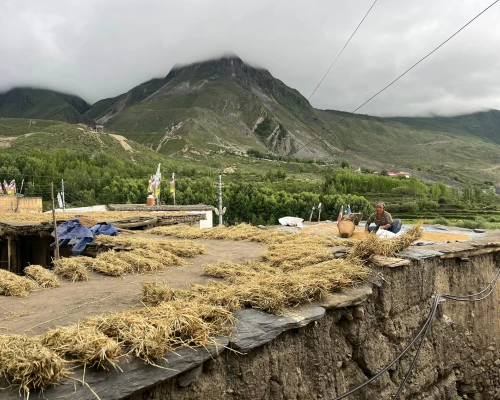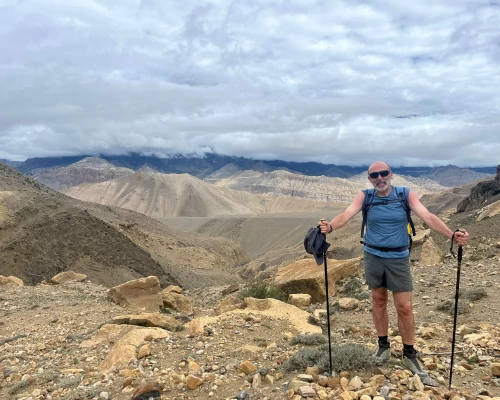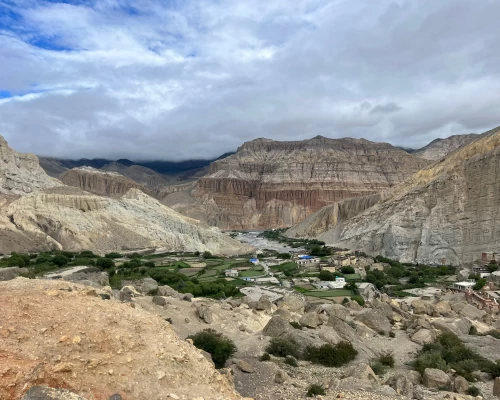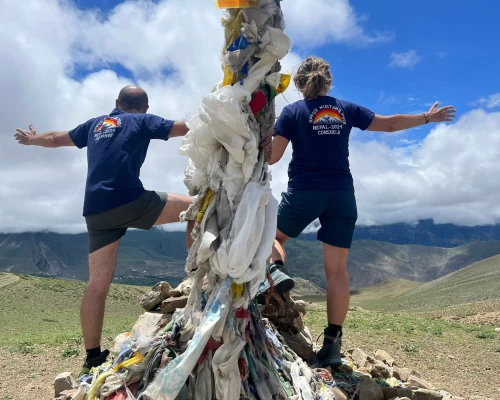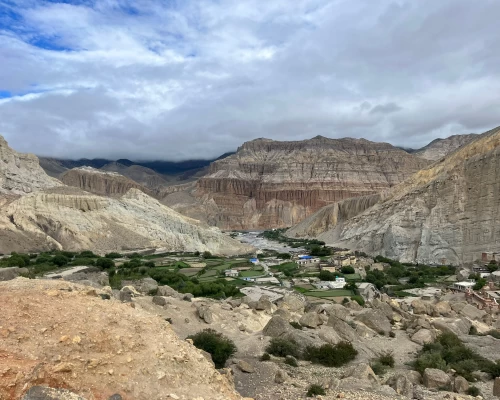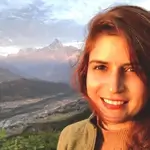The Upper Mustang Trek provides an excellent chance to discover the gradually unveiled Kingdom of Nepal, sometimes called "the last forbidden kingdom.” Hundreds of kilometers in the northern part of the Annapurna and Dhaulagiri regions feature a desert landscape that strongly contrasts with the rest of the green Nepalese valleys. The trek Mustang route leads adventure seekers to the Upper Mustang Valley, a destination steeped in history, where the Tibetan influence, including their dialect, continues to be strongly evident. Only in 1992 did this area become accessible to trekkers, and the requirement for an additional special permit to trek this region adds to its appeal.
The guests' final part is the offshoot of the once-strongest Kingdom of Lo, a walled city in Lo Manthang. Here, one can wander through narrow streets, see monasteries with lovely paintings on the walls, and taste the local atmosphere. Hiking to the Mustang Valley also presents an opportunity to explore the ancient sky caves of Chhoser, which are perhaps thousands of years old structures created naturally from the cliffs. These structures constitute an archaeological and anthropological heritage that could be used to understand the early history of that part of the world and convey the architectural wisdom of the early societies to present-day generations.
This trek is geographically somewhat similar to the Tibetan Plateau, with its arid terrain, absence of vegetation, vertically chiseled cliffs, and large gorges. While engrossed in the treks, one has wonderful sights, including the magnificent Nilgiri, Annapurna, and Dhaulagiri ranges. The trail goes through cultural villages including Kagbeni, Tsarang, and Ghami, and trekkers can see how people live. The trek is a cultural tour since the participants get a feel for the teeming festivals, dancing activities, and other cultural beliefs of the heavily dominant Tibetan-influenced people.
This is not just a physical journey; the trek to Nepal Mustang is also very much a cultural and spiritual journey. This trail is known for its beautiful natural scenery, the historical and cultural significance of the Upper Mustang Valley, and the fact that it is off the beaten tourist track. Whether it is the picturesque beauty or the history that depicts the past from a thousand years ago, the Upper Mustang Trek is one of the most exciting and wonderful trips in Nepal’s significant regions.
Why the Upper Mustang Trek?
The Upper Mustang Trek is an ideal and rewarding trekking destination, allowing trekkers to experience one of Nepal's most culturally and geographically diverse regions. The Upper Mustang district, located in the northern part of the country and adjacent to the intense and arresting Tibetan landscape, was virtually off-limits to outsiders until 1992. This seclusion has kept the region rich in mathematics and ancient Tibetan Buddhist culture, making it an open museum for anyone interested in exploring the region's history and traditions. For example, Upper Mustang trekking gives a fair chance to see the monasteries that are centuries old, watch colorful festivals, or simply accompany people who remain engaged in the traditional way of living because of the restrictions set by the Nepalese government.
The geography of the Upper Mustang Trek in Nepal may not be as colorful as the local culture. As you traverse this region, gorges, cliffs, and multi-hued rocks accentuate the desert-like vista, set against the snow-capped Himalayas. It boasts a unique geographical feature that bears a striking resemblance to the Tibetan Plateau, enhancing the trekking experience in Nepal. Some of the classic villages, such as Kagbeni and Tsarang, dot the upper portion of the trek, Mustang, providing opportunities for interaction with the friendly locals and an enriching experience of this beautiful geographic area. Also, the tour through such terrains does offer splendid scenes of famed mountains, including Nilgiri, Annapurna, and Dhaulagiri, just to mention a few.
Selecting the Upper Mustang Trek in Nepal also means going on a journey that involves discovery and exploration. The trek is moderate in the actual technical sense of the word, making it popular among hikers of middle and advanced fitness levels. While hiking, you will walk for hours without seeing another soul, and that is why it is a fantastic, unadulterated natural experience. The trek does not only concern a geographic exploration; the people and culture path also involves sighting temples and monasteries, meeting monks and discussing with them, as well as understanding the hidden religious context of the area. This makes the Upper Mustang trek attractive and enhances the experience for anyone looking for a perfect trekking destination in Nepal.
The ideal time for the Upper Mustang trek
The preferred seasons for Upper Mustang trekking are March to June and September to November. Such periods are always ideal for trekking since they are characterized by favorable weather conditions that would enable the trekkers to have a relaxing time in the region without having to also deal with very harsh weather that would affect their health.
Spring (March to June)
One of the best seasons for the Upper Mustang trek is spring. Throughout this season, it is a mild year, with day temperatures ranging from 16 to 22 degrees Celsius. We advise you to exercise caution on higher ground as nighttime temperatures may drop significantly. Flowers bloom in the desert, providing a welcome respite from the harsh landscape. The overall weather can be fairly good, with very little to no cloud cover, offering a panoramic view of the Himalayas and the terrain of the Mustang. Also, the spring season is culturally active because festivals like the Tiji festival are much cherished locally, and visitors get a chance to witness the cultural aspect of the area.
Autumn (September to November)
Autumn is another favorable time to go for the Upper Mustang trek. Generally, during this season, the weather is favorable, characterized by a clear sky and cool dews like in the spring. The trekking tail comprises a post-monsoon period to ensure fewer storms and fewer dusty trails for better trekking. During the day, it is not very hot or cold, which simplifies travel since people can travel longer distances without getting too hot or too cold. It is also one of the best seasons for trekkers because it gives a clear view of the mountains and a lush, colorful view of the Mustang Valley. The cultural immersion is still present; one can still interact with the locals and see how they live their lives, presumably the way they were before the modernization, in Upper Mustang.
Similarly, Best Trekking in Nepal recommends the Upper Mustang trek in spring or autumn, when the chances of encountering unfavorable weather are minimal.
Why travel with us?
Deciding to travel with the Hiking Adventure Team for the Upper Mustang Trek allows you to achieve the best authentic experience in one of Nepal's most beautiful areas without many concerns. Our local guides are knowledgeable when it comes to the fine details of the Mustang Valley and its history, thus giving you a better understanding of the area. We prioritize your safety throughout the trek, providing professional care from acclimatization to emergency plans. Expertly planned daily routes and knowledge of the best places to stay allow travelers to get the most out of the Upper Mustang trek in terms of both experience and comfort.
We handle all the preparations, including securing necessary permissions, scheduling services, and arranging transportation, leaving you free to relish the lively atmosphere and unforgettable scenery. We thus take responsibility for offering ethical and responsible travel and ensure that visiting Mustang Valley also contributes to the much-needed support and development of the community that resides in this region while respecting the cultural and natural ethnicity of this area. When you go trekking with us, you are not just choosing a trek that offers you unique experiences; you are also choosing a trek that benefits the region you are visiting.


